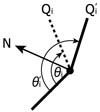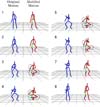Digital Humanities
DH2010
King's College London, 3rd - 6th July 2010
Generation of Emotional Dance Motion for Virtual Dance Collaboration System
See Abstract in PDF, XML, or in the Programme
Seiya, Tsuruta
Graduate School of Science and Engineering, Ritsumeikan University,
Japan
seiya@img.is.ritsumei.ac.jp
Woong, Choi
Global Innovation Research Organization, Ritsumeikan University,
Shiga, Japan
Kozaburo, Hachimura
Department of Media Technology, College of Information Science and
Engineering, Ritsumeikan University, Shiga, Japan
Measurement of body motion using motion capture systems has become widespread in the fields of entertainment, medical care, and biomechanics research.
In our laboratory, we are undertaking research on the application of digital archiving and information technology to dancing [Hachimura, 2006]. For example, quantitative analysis of traditional dance motion [Yoshimura et al., 2006] and 3D character animations of traditional performing arts using virtual reality [Furukawa et al., 2006]. Recently, we have measured many kinds of dance motion, not only Japanese traditional dances, but also contemporary street dances.
Dance collaboration system is one of the typical collaboration systems based on body motion. In our laboratory, we are developing a Virtual Dance Collaboration System [Tsuruta et al., 2007]. Live dancer’s motion is captured by optical motion capture system, and the dance collaboration system recognizes it in real-time. A virtual dancer responds to the live dancer’s motion. The live dancer performs a dance to the music, and a virtual dancer reacts with a dance by using the motion data stored in a motion database. It is desirable to generate a virtual dancer’s motion according to the live dancer’s emotion or music emotion.
In this paper, we describe a method to generate emotional dance motions by modifying a standard dance motion which is stored in a database.
Overview of the Virtual Dance Collaboration System
A configuration of the system is shown in Figure 1. Our proposed system provides users with collaboration with virtual dancers through dancing. The collaboration system consists of an optical real-time motion capture and an immersive virtual environment system. An optical motion capture system is able to measure body motion precisely and in real-time. Immersive virtual environment provides users stereoscopic display and feeling of immersion.
The system has three sections: “Motion processing section”, “Music processing section” and “Graphics processing section”.
In the “Motion processing section”, the system recognizes a live dancer’s motion in real-time, and determines a virtual dancer’s reactive motion. In the “Music processing section”, the system extracts emotional information from music in real time. In the “Graphics processing section”, the system regenerates a virtual dancer’s motion by using extracted emotional information from music, and the system displays 3DCG character animation by using immersive virtual environment.
Generation of Emotional Dance Motion
For our system, it is necessary to generate a virtual dancer’s emotional motion in real-time. We developed a system named Emotional Motion Editor (EME).
Emotional Motion Editor
The EME generates emotional dance motions by modifying the original motion data by changing the speed of motion or altering the joint angles interactively. To generate an emotional motion, a function of changing the size of motion is implemented within the EME.
To generate virtual dancer’s emotional motions in real-time, we need a simple method which can calculate with few order. For this purpose, we employ a method altering the interior angle of two connecting body segments as shown in Figure 2.
Qi and Q′i is an original vector and a vector after rotating respectively. Where θi is an original angle, and θ'i is an after rotating angle respectively. The rotation matrix is calculated by using equation (1).
Where RN (θ'i− θi ) matrix for rotation about vector N . N is a normal vector represented by equation (2). Where × means outer product.
Change the size of the motion is indicated by equation (3).
Constant α and β are coefficient for amplification and bias respectively. Where θ′i is amplified angle, θ̅i is average of angles in sliding window at frame i as shown in equation (4). k is a half of the size of the sliding window.
A screen shot of the EME is displayed in Figure 3. A character model on the left shows an original dance motion. A model on the right shows generated emotional motion after modification.
Relation between Emotion and Body Motion
We examine the correlation between emotion and body motion in dancing by interviewing the dancer. We employ 5 kinds of emotions (Neutral, Passionate, Cheerful, Calm, Dark). “Neutral” is a standard motion. Motion features appeared on each human emotional motion are shown in Table I. We then obtained parameters empirically with a dancer. Parameters used for generating emotional motions are shown in Table II. Figure 4(a) shows an example of motion modification. A thin line in Figure 4(b) shows an original graph of angle variation of the right knee. The thick line shows a modified graph. In this case, α and β was given 3.0 and -25.0 respectively.
Experiments
We generate 4 kinds of emotional motions by using EME according to Table II.
To evaluate generated emotional motions, we conducted 2 types of assessment experiment by using questionnaire survey.
Method of Experiment
Experiment 1
Experiment 1 is a comparison between
neutral standard motion and artificially generated emotional motions.
Experiment 2
Experiment 2 is a comparison between
motion-captured emotional motions and artificially generated emotional
motions.
For the experiment, we used 9 kinds of motions as the following:
- 4 Emotional motions (performed by dancer)
- 1 Standard motion (performed by dancer)
- 4 Artificial emotional motions (generated by EME)
Result of Experiments
The results of Experiment 1 are shown in Figure 5. This figure shows score averages, standard deviations and significant differences by the t-test. Black circles show standard motions, triangles show generated artificial emotional motions. As shown in Figure 5, all kinds of scores except "Calm" are higher than standard motion. We found that the respondents receive an impression of each emotion through artificial emotional motion.
Figure 6 indicates the results of Experiment 2. White circles show motion-captured emotional motions, and triangles show generated artificial emotional motions by using EME. As a result of the t-test, there is no significant difference. We found that respondents received similar impressions of emotional motions from generated artificial emotional motions. We verified that our EME system is effective in generating emotional motions.
Conclusion and future works
In this paper, we described a method to generate emotional dance motions by modifying the standard dance motion.
To generate emotional motions, we developed the Emotional Motion Editor. We conducted two experiments to evaluate generated emotional motions. As a result, we confirmed that EME can generate emotional motions by altering motion speed and joint angles.
As future work, implementation of the motion processing section and the motion modification function is necessary in the Virtual Dance Collaboration System.
Acknowledgements
This research has been partially
supported by the Global COE Program “Digital Humanities Center for Japanese Arts
and Cultures”, the Grant-in-Aid for Scientific Research No.(B)16300035, all from
the Ministry of Education, Science, Sports and Culture. We would like to give
heartfelt thanks to Prof. Y. Endo, Ritsumeikan Univ. whose comments and
suggestions were of inestimable value for our research. We would also like to
thank Ms. Gotan and Mr. Morioka who support many experiments.
References
- Furukawa, K.et al. (2006). CG Restoration of Historical Noh Stage and its use for Edutainment. Proc. VSMM06. Pp. 358-367
- Hachimura, K. (2006). 'Digital Archiving of Dancing'. Review of the National Center for Digitization (Online Journal). V. Vol.851-66. http://www.ncd.matf.bg.ac.yu/casopis/08/english.html (accessed 12 March 2010)
- Tsuruta, S. et al. (2007). 'Real-Time Recognition of Body Motion for Virtual Dance Collaboration System'. Proceedings of 17th International Conference on Artificial Reality and Telexistence (ICAT 2007). (2007), pp. 23-30
- Yoshimura, M. et al. (2006). 'Analysis of Japanese Dance Movements Using Motion Capture System'. Systems and Computers in Japan. V. Vol.37 No.1: 71-82, Translated from Densi Joho Tsushin Gakkai Ronbunshi, Vol. J87-D- II, No.3
© 2010 Centre for Computing in the Humanities
Last Updated: 30-06-2010











